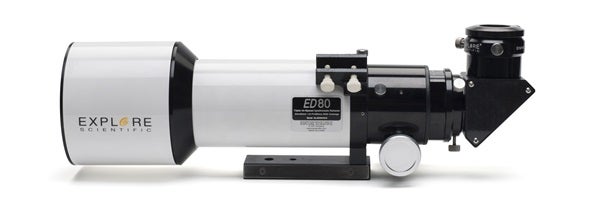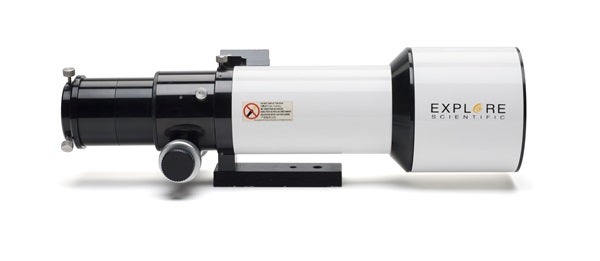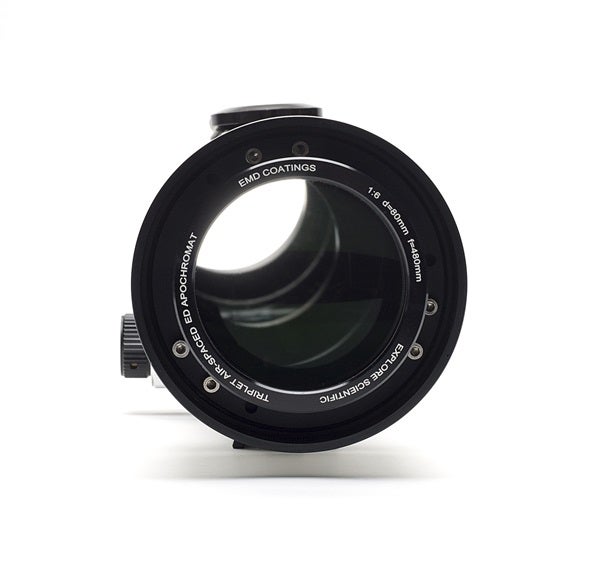I was well aware of the incredibly sharp optics delivered by APOs (and of Explore’s great reputation with them), but I’ve been skeptical of their typically short focal ratios. What would be the capability of an 80mm scope (whose lens measures a scant 3.15 inches in diameter) with a focal ratio of just f/6?
Improvising a mount
First, I had to get the ED80 up and running, not an easy task because the model I tested came with just the optical tube assembly — no mount, finder, or eyepieces. The last was no problem because this scope accepts both 1¼” and 2″ eyepieces. The mount was a different matter. The ED80 comes with a standard Vixen dovetail plate. Standard to most amateur astronomers, but I didn’t have a match for it. Seems like I need an upgrade.
Anyway, I made a quick trip to a local hardware store looking for anything (hose clamps, nuts and bolts, etc.) that would let me affix the scope to one of my equatorial mounts. I finally settled on that universal of all fixer-uppers: duct tape. Not pretty, but it worked. (In case you’re wondering, I wrapped paper around the tube first so the tape didn’t leave a residue.) None of my finders was compatible with the ED80 either, but a green laser pointer fit into the finder notch, and I was ready to go.
First light was the traditional first stop for most scopes — the Moon. The images were as razor sharp as I’d expected without the usual color distortion that hampers traditional refractors with two-element lenses. From the Moon, I moved to Saturn. Atmospheric turbulence due to the planet’s low altitude distorted the image, but at times the Cassini Division really stood out. Not bad for a 3-inch scope.
There seemed to be a problem, however. With most of my eyepieces, the focuser (a smooth, two-speed rack-and-pinion version) would reach its back limit before I could obtain a sharp image. I resorted to slowly raising each eyepiece until the image became sharp, and then securing it with the eyepiece-holding screw. The following day, I figured out the focusing problem.
When I unpacked the ED80, I noticed there wasn’t a user’s manual. Without one, I was unable to identify a pair of threaded metal tubes that came in the box. Thinking about them and my dilemma, I realized they were tube extenders. Sure enough, when I fit one between the main tube and the focuser, that solved my problem.
Under the sky
The next night, I really put the ED80 to work. I began with Epsilon (ε) Lyrae, the famous Double Double. Using an eyepiece that would normally notch this system with the long-focus refractors I’m familiar with didn’t provide the necessary magnification. So I changed to a 5mm orthoscopic, an eyepiece I rarely use because the images are sharp only on nights of exceptional seeing. With a resulting 96x, the two stellar pairs were just resolvable. Then I really went nuts. Or so I thought.
I switched to a 3.2mm planetary eyepiece that upped the magnification to 150x, which approached the theoretical upper limit for a 3-inch scope. Now the Double Double was beautifully resolved with each star displayed as a pinpoint. But I wasn’t finished yet.
On a whim, I placed the 3.2mm eyepiece into a 2x Barlow lens to achieve 300x — way beyond the supposed magnification limit for a 3-inch. When I gazed into the eyepiece, the four members of the Double Double showed surprisingly well, leaving me to wonder what this scope might do on a night of optimal seeing conditions. I have no doubt the ED80 can achieve its advertised resolving limit of 1.45″.
On the third evening, I decided to test the magnitude reach of the ED80. (Specs claim a limiting magnitude of 12.) Working with an American Association of Variable Star Observers chart of the long-period variable RY Cephei, I was able to obtain a steady view of a magnitude 12.1 star and caught fleeting glimpses of one listed at magnitude 12.5. The little APO passed the test with flying colors!
The bottom line
Overall, the performance of Explore Scientific’s Essential Series 80mm Apochromatic Refractor was nearly flawless. My experience with it certainly sold me on this type of optical configuration. Small and portable, it’s an ideal grab-and-go telescope.
It’s also extremely versatile, able to capture wide-field views spanning several degrees while also providing the high-power punch to tease out lunar and planetary detail and split close double stars. And in the future, I’ll have the proper mount for it!













